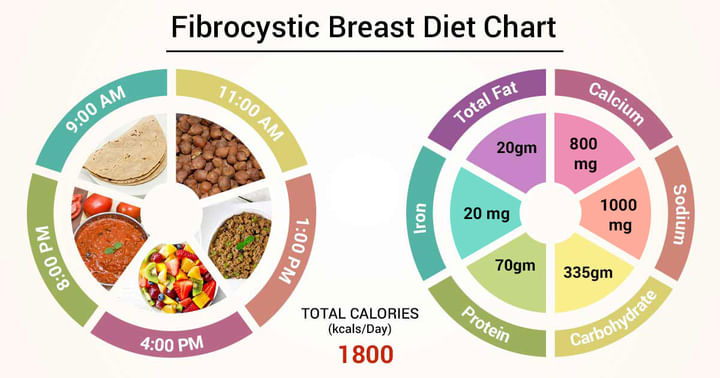Diet Chart For Fibrocystic Breast Disease
Last Updated: Aug 27, 2020
About Fibrocystic Breast Disease Diet
Fibrocystic breast is defined as a state where a woman feels her breast lumpy due to small breast masses or breast cysts. It is very common for women of all ages (the 20s to 50s) and sometimes causes pain or discomfort in the breast.
Patient should have a Fibrocystic breast disease diet plan.
- There should be reduced in sodium.
- Take less salty food so that reduced salt levels will help in minimizing retained fluids and size of the cysts.
- Avoid consuming alcohol, so that the liver can produce more estrogens in the body to combat this disease.
- Avoid saturated fats, including meat, eggs, cheese, full-fat yogurt and high-fat dairy products.
- Also, avoiding all caffeinated beverages and food, including coffee, tea, and chocolates will add benefits.
Women suffering from fibrocystic breast disease should increase flax seeds in the fibrocystic breast disease diet. Flaxseeds are a rich source of omega 3 fatty acids and helps in reducing inflammation. Consuming ground flaxseeds or cold pressed seeds in the diet will be healthy. Include more cruciferous vegetables in the diet because they contain the indole-3-carbinol compound which help in excretion of estrogens hormone from the liver and prohibits tumor growth. Cruciferous vegetables are cabbage, cauliflower, broccoli, Brussels sprouts, and kale.
Fiber-rich food also helps in eliminating excess hormones and toxins from the body which later inhibits this disease. Fibrous food includes whole grain, fruits, and vegetables.
To Deal with fibrocystic breast, we create the best diet plan for fibrocystic breast patients suffering from it. In this fibrocystic breast diet plan, we create 7 Day meal plan which you can repeat, we also listed out the consumption timing of which includes breakfast, lunch, and dinner.
These healthy meals are listed after discussion with professional dietitians. Also, try to avoid these food items listed in the fibrocystic breast diet plan. In this Indian diet plan for fibrocystic breast patients, you need to make some lifestyle changes also.
Diet chart for fibrocystic breast disease
| Sunday | |
| Breakfast (8:00-8:30AM) | Soya flour roti 3+ 1 tbs green chutney. |
| Mid-Meal (11:00-11:30AM) | 1 cup boilled channa+ olive oil. |
| Lunch (2:00-2:30PM) | 1 cup rice+ Soya chunk curry1/2 cup+ Ladies finger subji 1/2 cup+ 1/2 cup curd |
| Evening (4:00-4:30PM) | 1 cup fruit salad |
| Dinner (8:00-8:30PM) | Buck wheat roti 2.+ Tomato subji 1/2 cup. |
| Monday | |
| Breakfast (8:00-8:30AM) | Mix veg Poha 1 cup+ 1/2 cup low fat milk. |
| Mid-Meal (11:00-11:30AM) | Broccoli salad 1/2 cup |
| Lunch (2:00-2:30PM) | 1 cup rice + 1/2 cup cluster beans subji+ Fish curry(80 gm fish) 1/2 cup. |
| Evening (4:00-4:30PM) | 1 cup fruit salad |
| Dinner (8:00-8:30PM) | 2 roti/ Chapathi+ Ladies finger subji 1/2 cup. |
| Tuesday | |
| Breakfast (8:00-8:30AM) | Vegetable Oats Upma 1 cup+ 1/2 cup low fat milk. |
| Mid-Meal (11:00-11:30AM) | plane Yoghurt with raw vegetables / grilled vegetables -1 cup( avoid starchy vegetables) |
| Lunch (2:00-2:30PM) | 1 cup rice + 1/2 cup Kidney beans curry+ Snake guard subji 1/2 cup+1/2 cup curd |
| Evening (4:00-4:30PM) | 1 cup fruit salad |
| Dinner (8:00-8:30PM) | Broken wheat upma 1 cup+ 1/2 cup green beans subji |
| Wednesday | |
| Breakfast (8:00-8:30AM) | Chapati 3+ Egg curry (1 egg) |
| Mid-Meal (11:00-11:30AM) | Tomato Brussel sprouts salad 1/2 cup |
| Lunch (2:00-2:30PM) | Veg pulav rice 1 cup+ 1/2 cup Soya Chunk curry+ 1/2 cup curd |
| Evening (4:00-4:30PM) | 1 cup fruit salad |
| Dinner (8:00-8:30PM) | Wheat dosa 3 + 1/2 cup Bitter guard subji. |
| Thursday | |
| Breakfast (8:00-8:30AM) | 4 Idli(rice) + Sambar 1/2 cup/ 1 table spoon Gren chutney/ Tomato Chutney |
| Mid-Meal (11:00-11:30AM) | green gram sprouts 1 cup+ Olive oil+ Black pepper |
| Lunch (2:00-2:30PM) | 1 cup brown rice + Chicken curry 1/2 cup + 1/2 cup cabbage subji+ 1/2 cup curd |
| Evening (4:00-4:30PM) | 1 cup fruit salad |
| Dinner (8:00-8:30PM) | 2 Roti/ chapati+ 1/2 cup mix veg curry |
| Friday | |
| Breakfast (8:00-8:30AM) | Moong dal cheela- 3+ Tomato chutney. |
| Mid-Meal (11:00-11:30AM) | Brussels sprouts salad 1/2 cup |
| Lunch (2:00-2:30PM) | 1 cup rice+ 1/2 cup Dhal+ Palak subji 1/2 cup+ 1/2 cup curd. |
| Evening (4:00-4:30PM) | 1 cup fruit salad |
| Dinner (8:00-8:30PM) | Broken wheat upma 1 cup+ 1/2 cup green beans subji |
| Saturday | |
| Breakfast (8:00-8:30AM) | Rice dosa-3+ 1/2 cup. |
| Mid-Meal (11:00-11:30AM) | plane Yoghurt with raw vegetables / grilled vegetables -1 cup( avoid starchy vegetables) |
| Lunch (2:00-2:30PM) | 1 cup rice+ Cauliflower subji 1/2 cup+ Dal 1/2 cup |
| Evening (4:00-4:30PM) | 1 cup fruit salad |
| Dinner (8:00-8:30PM) | 2 Roti / chappathi+Ridge guard subji 1/2 cup. |
Fibrocystic Breast Disease Diet Restrictions: Food Items To Limit
Try to avoid these food items and beverages while following diet to cure fibrocystic breast disease:
- Caffeine: Eliminate caffeinated beverages and foods, including coffee, sodas, tea and chocolates, for four to six months.
- Alcohol: Liminating alcohol from the diet brings to the liver, which also works to process out excess estrogen in the body, which is a contributor to fibrocystic breast disease.
- Salty Foods: Cutting out or dramatically lowering the salt levels in your diet may help reduce retained fluids and the size of your cysts.
What To Eat And Avoid To Manage Fibrocystic Breast Disease
- Minimize Caffeine : Methylxanthines in caffeine can worsen your symptoms so try to avoid them. These stimulants include coffee, black tea, chocolate and cocoa, caffeinated soft drinks and some over the counter medications.
- Reduce Saturated Fat : Studies show that saturated fat (in red meat and dairy products) can worsen fibrocystic breast disease.
- Increase Fiber Intake : Fiber helps the body eliminate excess hormones and toxins which can worsen fibrocystic breast disease. Good sources of fiber include whole grains, vegetables, fruits and seeds such as flaxseeds.
- Eat More Cruciferous Vegetables : Cruciferous vegetables include cabbage, cauliflower, broccoli, Brussel sprouts and kale. These vegetables contain a natural compound called indole-3-carbinol that helps in estrogen excretion by the liver and inhibit tumor growth.
- Eat Flaxseeds : Flaxseeds are a source of omega 3 fatty acids that help reduce inflammation. They are also a source of fiber and contain lignans that act as phytoestrogen and help block the effect of bad estrogen on breast tissue. Ground flaxseeds and cold-pressed flaxseed oil are a very beneficial to your daily diet.
Food Items You Can Easily Consume In Fibrocystic Breast Disease Diet
- Soy : Women who regularly get lots of daidzein and genistein, two compounds found in soybeans, tofu, tempeh, and miso, have a lower incidence of fibrocystic breasts.
- Wheat germ : Women who took the wheat germ extract also saw a decrease in fatigue, irritability, heart palpitations, headaches, sleep problems, increased appetite, and food cravings. To reap the benefits, sprinkle wheat germ over a salad or blend it.
- Blueberries : Eat one single 6 oz serving of blueberries daily for the cancer-fighting benefits. Or buy blueberry powder, which can be used in smoothies, added to granola, stirred into yogurt, sprinkled onto oatmeal, or used in baked goods.
- Sage tea : While drinking sage tea or adding fresh sage to your dinner might suffice, some sources suggest taking a 1,000 mg dried sage capsule twice a day for maximum sweat prevention.
References
- Galvan-Portillo M, anchez LT, Lopez-Carrillo L. Dietary and reproductive factors associated with benign breast disease in Mexican women. Nutrition and cancer. 2002 Jul 1;43(2):133-40. [Cited 30 June 2019]. Available from:
- VOBECKY J, SIMARD A, VOBECKY JS, GHADIRIAN P, LAMOTHE-GUAY MO, FALARDEAU M. Nutritional profile of women with fibrocystic breast disease. International journal of epidemiology. 1993 Dec 1;22(6):989-99. [Cited 30 June 2019]. Available from:
- Webb PM, Byrne C, Schnitt SJ, Connolly JL, Jacobs TW, Baer HJ, Willett WC, Colditz GA. A prospective study of diet and benign breast disease. Cancer Epidemiology and Prevention Biomarkers. 2004 Jul 1;13(7):1106-13. [Cited 06 August 2019]. Available from:
Table of content
Find Dietitian/Nutritionist near me
Ask a free question
Get FREE multiple opinions from Doctors



